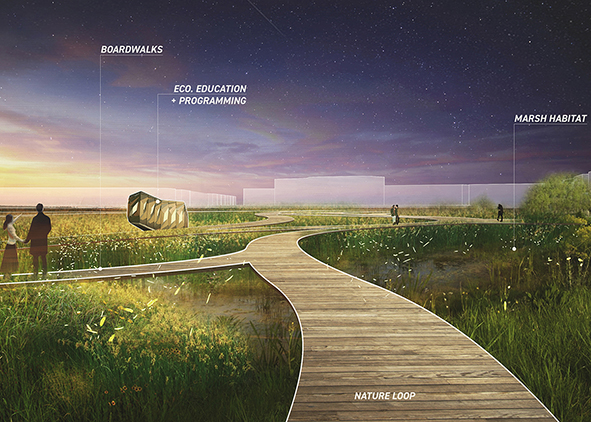Making innovative landscapes. Balmori Associates redefining the human-nature relationship for the cities of the future
DOI:
https://doi.org/10.19229/2464-9309/1322023Keywords:
Balmori Associates, innovative landscapes, active landscapes, data collection, benefit quantificationAbstract
In the context of the current scholarly debate on environmental and ecological emergency, the contribution presents the work of landscape architect Diana Balmori and Balmori Associates, which has emerged as one of the most visionary and innovative in combating climate change and creating more liveable cities. The description of some of the work carried out by the Firm helps illustrate the foundational and representative elements that characterise its design work, but more importantly, the strategies to be deployed in order to successfully respond to current critical environmental issues. Diana Balmori’s work is a rare compendium of interventions grounded in scientific research and capable of silently but steadily influencing our current vision of Landscape Architecture, laying solid foundations for a more liveable, sustainable, equitable and accessible urban space and for the creation of ‘operational’ landscapes that help define a new relationship between the 21st-century city and nature.
Article info
Received: 02/05/2023; Revised: 05/05/2023; Accepted: 05/06/2023
Downloads
Article Metrics Graph
References
Balmori, D. (2014), Drawing and reinventing landscape, Wiley, Chichester.
Balmori, D. (2010), A Landscape Manifesto, Yale University Press. [Online] Available at: yalebooks.yale.edu/book/9780300156584/a-landscape-manifesto [Accessed 20 May 2023].
D’Arienzo, R. and Younès, C. (eds) (2018), Synergies Urbaines – Pour un métabolisme collectif des villes, Métiss Press, Paris.
Dal Falco, F., Veneziano, R. and Carlomagno, M. (2022), “Collaborazione tra natura e artificio – Processi simbiotici tra scienze, arti e design | Natural and artificial interaction – Symbiotic processes between science, art and design”, in Agathón | International Journal of Architecture, Art and Design, vol. 11, pp. 274-287. [Online] Available at: doi.org/10.19229/2464-9309/11252022 [Accessed 20 May 2023].
Eiseley, L. C. (1959), “Charles Darwin, Edward Blyth, and the theory of Natural Selection”, in Proceedings of the American Philosophical Society, vol. 103, issue 1, pp. 94-158. [Online] Available at: jstor.org/stable/985383 [Accessed 20 May 2023].
Faivre, N., Fritz, M., Freitas, T., Boissezon, B. and Vandewoestijne, S. (2017), “Nature-based solutions in the EU – Innovating with nature to address social, economic and environmental problems”, in Environmental Research, vol. 159, pp. 509-518. [Online] Available at: doi.org/10.1016/j.envres.2017.08.032 [Accessed 20 May 2023].
Gausa, M. (2022), “Topologie verdi e paesaggi oltre il paesaggio – 30 anni di ricerche avanzate sulla ibridizzazione del verde | Green topologies and landscapes beyond the land – A 30-years research on green hybridization”, in Agathón | International Journal of Architecture, Art and Design, vol. 11, pp. 14-25. [Online] Available at: doi.org/10.19229/2464-9309/1112022 [Accessed 12 March 2023].
Levit, G. S. and Hossfeld, U. (2019), “Ernst Haeckel in the history of biology”, in Current Biology Magazine, vol. 29, issue 24, R1276-R1284. [Online] Available at: doi.org/10.1016/j.cub.2019.10.064 [Accessed 20 May 2023].
Levit, G. S. and Hossfeld, U. (2017), “Major research traditions in twentieth-century evolutionary biology – The relations of Germany’s Darwinism with them”, in Delisle, R. (ed.), The Darwinian Tradition in Context, Springer Nature, Cham, pp. 169-193. [Online] Available at: doi.org/10.1007/978-3-319-69123-7_8 [Accessed 20 May 2023].
Meadows, D. H., Meadows, D. L., Randers, J. and Behrens III, W. W. (1972), The limits to Growth – A report for the Club of Rome’s project on the predicament of mankind, Universe Books, New York. [Online] Available at: donellameadows.org/wp-content/userfiles/Limits-to-Growth-digital-scan-version.pdf [Accessed 20 May 2023].
Perchinunno, P., Massari, A., L’Abbate, S. and Mongelli, L. (2023), “Ecological transition and sustainable development – A multivariate statistical analysis to guide the policies of the national recovery and resilience plan”, in Social Indicators Research | An International and Interdisciplinary Journal for Quality-of-Life Measurement, pp. 1-15. [Online] Available at: doi.org/10.1007/s11205-023-03078-w [Accessed 20 May 2023].
Scalisi, F. and Ness, D. (2022), “Simbiosi tra vegetazione e costruito – Un approccio olistico, sistemico e multilivello | Symbiosis of greenery with built form – A holistic, systems, multi-level approach”, in Agathón | International Journal of Architecture, Art and Design, vol. 11, pp. 26-39. [Online] Available at: doi.org/10.19229/2464-9309/1122022 [Accessed 20 May 2023].
UN – United Nations (2019), World Population Prospects 2019 – Highlights. [Online] Available at: population.un.org/wpp/Publications/Files/WPP2019_Highlights.pdf [Accessed 20 May 2023].
UN – United Nations (1987), Report of the World Commission on Environment and Development – Our Common Future. [Online] Available at: sustainabledevelopment.un.org/content/documents/5987our-common-future.pdf [Accessed 20 May 2023].
UN Environment and IEA – International Energy Agency (2017), Global Status Report 2017 – Towards a zero-emission, efficient and resilient buildings and construction sector. [Online] Available at: worldgbc.org/wp-content/uploads/2022/03/UNEP-188_GABC_en-web.pdf [Accessed 20 May 2023].
Williams, R. (1988), Keywords – A vocabulary of culture and society, Fourth Estate Ltd. [Online] Available at: harpercollins.co.uk/products/keywords-a-vocabulary-of-culture-and-society-raymond-williams?variant=40147304513614 [Accessed 20 May 2023].
Xing, Y., Jones, P. and Donnison, I. (2017), “Characterisation of nature-based solutions for the built environment”, in Sustainability, vol. 9, issue 1, article 149, pp. 1-20. [Online] Available at: mdpi.com/2071-1050/9/1/149 [Accessed 20 May 2023].

Downloads
Published
How to Cite
Issue
Section
Categories
License
Copyright (c) 2023 Javier González-Campaña, Noemie Lafaurie-Debany, Marta Rabazo Martin

This work is licensed under a Creative Commons Attribution 4.0 International License.
This Journal is published under Creative Commons Attribution Licence 4.0 (CC-BY).
License scheme | Legal code
This License allows anyone to:
Share: copy and redistribute the material in any medium or format.
Adapt: remix, transform, and build upon the material for any purpose, even commercially.
Under the following terms
Attribution: Users must give appropriate credit, provide a link to the license, and indicate if changes were made; users may do so in any reasonable manner, but not in any way that suggests the licensor endorses them or their use.
No additional restrictions: Users may not apply legal terms or technological measures that legally restrict others from doing anything the license permits.
Notices
Users do not have to comply with the license for elements of the material in the public domain or where your use is permitted by an applicable exception or limitation.
No warranties are given. The license may not give users all of the permissions necessary for their intended use. For example, other rights such as publicity, privacy, or moral rights may limit how you use the material.


















































































